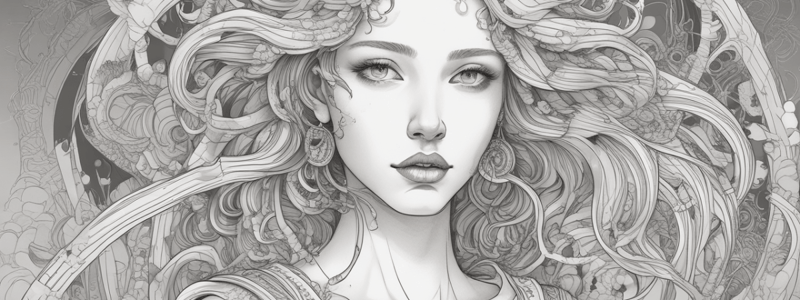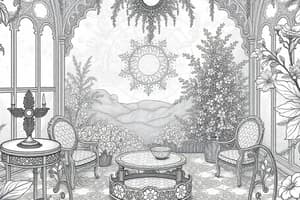Podcast
Questions and Answers
What is the primary function of positive space in art?
What is the primary function of positive space in art?
- To highlight negative space
- To create the illusion of depth
- To define shapes and forms (correct)
- To create balance and harmony
What is the term for the empty or open area surrounding the main subject?
What is the term for the empty or open area surrounding the main subject?
- Empty space
- Blank space
- Positive space
- Negative space (correct)
What is achieved by using overlapping, size, and placement in art?
What is achieved by using overlapping, size, and placement in art?
- Contrast and texture
- Depth and perspective (correct)
- Balance and harmony
- Symmetry and unity
What is the purpose of atmospheric perspective in art?
What is the purpose of atmospheric perspective in art?
What is the main focus of M.C. Escher's 'Relativity'?
What is the main focus of M.C. Escher's 'Relativity'?
What is the relationship between positive and negative space?
What is the relationship between positive and negative space?
What is the term for the area where objects and forms exist in a picture?
What is the term for the area where objects and forms exist in a picture?
What is the purpose of paying attention to both positive and negative space?
What is the purpose of paying attention to both positive and negative space?
What is an example of how artists use space to create depth?
What is an example of how artists use space to create depth?
What is the effect of using negative space in art?
What is the effect of using negative space in art?
Flashcards are hidden until you start studying
Study Notes
ART ELEMENTS: Line
- A line is a mark that connects two points and can be straight, curved, zigzag, wavy, or dotted.
- Characteristics of lines: vary in length, thickness, and direction, and are like the building blocks of drawings and can create shapes and forms.
- Types of lines:
- Straight Line: draws a straight line from one end of a paper to the other.
- Curved Line: creates a line that curves like a smiley face.
- Zigzag Line: makes a line that looks like a lightning bolt.
- Wavy Line: draws a line that flows like ocean waves.
- Dotted Line: connects the dots to make a dotted line.
How Artists Use Lines
- Artists use lines to outline shapes and create the structure of their artwork.
- Lines can show movement, express emotions, or guide the viewer's eye through a picture.
ART ELEMENTS: 2D Shape
- 2D shapes are flat and have only two dimensions: length and width.
- Characteristics of 2D shapes:
- Can be geometric (like squares, circles, and triangles) or organic (freeform and irregular).
- Geometric shapes are flat, two-dimensional figures with well-defined boundaries.
- Organic shapes refer to irregular, freeform shapes often found in nature or inspired by natural forms.
Types of 2D Shapes
- Geometric shapes:
- Square
- Circle
- Triangle
- Rectangle
- Oval
- Organic shapes:
- Structureless or Blob Shapes
- Plant Shapes
- Cloud-Like Shapes
- Organic Spirals
- Wave-Like Patterns
- Cellular Structures
- Animal-Inspired Shapes
- Root-Like Patterns
How Artists Use 2D Shapes
- Artists use 2D shapes to create the structure and form in their artwork.
- Different shapes can evoke different feelings and moods.
ART ELEMENTS: 3D Forms
- 3D forms have three dimensions: length, width, and depth.
- Characteristics of 3D forms:
- Artists use forms to create sculptures, pottery, and other artworks with depth.
- Forms can be geometric (like cubes and spheres) or organic (representing natural, freeform shapes).
- Geometric 3D forms:
- Cube
- Sphere
- Cylinder
- Pyramid
- Organic 3D forms:
- Abstract Natural Forms
- Wave-Like Structures
- Tree-Like Sculptures
- Animal-Inspired Sculptures
- Human Body Sculptures
How Artists Use 3D Forms
- Artists use 3D shapes to add depth and realism to their creations.
- Sculptors, in particular, mold and carve materials to form three-dimensional artworks.
ART ELEMENTS: Tonal Value
- Tonal value is the range of lightness and darkness in a piece of art.
- Understanding Tonal Value:
- Light and Dark: tonal value is about the contrast between light and dark.
- Creating Form: tonal value gives flat shapes a three-dimensional appearance.
- Shading Techniques:
- Hatching and Cross-Hatching
- Blending
- Stippling
- Scumbling
- Tips for Effective Shading:
- Start Light
- Study Light and Shadow in Nature
- Tonal Value in Colour:
- Using colour to create tonal value is similar to using black and white.
ART ELEMENTS: Texture
- Texture is how something feels or looks like it might feel if we could touch it.
- Types of textures:
- Smooth Texture: feels soft to the touch and often gives a sense of calmness and simplicity.
- Rough Texture: adds a bit of excitement and energy to our artwork.
- Smooth textures:
- Glassy Smooth
- Silky Smooth
- Feathery Smooth
- Rough textures:
- Bumpy Rough
- Grainy Rough
- Jagged Rough
- Actual Texture: the physical feel of a surface.
- Implied Texture: the appearance or perception of texture based on what our eyes see.
How Artists Use Texture
-
Artists use texture to add depth and realism to their creations.
-
Texture can evoke different emotions and moods in the viewer.### Colour
-
Colour is a crucial element of art, making everything look bright and beautiful.
-
Colours are made up of different hues, like red, blue, yellow, and more.
-
Characteristics of colour include being warm (like red, orange, and yellow) or cool (like blue, green, and purple).
3 Types of Colour
- Primary Colors: Three primary colours are red, blue, and yellow, which all other colours come from mixing.
- Secondary Colors: Mixing two primary colours together creates three secondary colours: orange, green, and purple.
- Tertiary Colors: Made by mixing a primary colour with a secondary colour, examples include red-orange, blue-green, and yellow-purple.
Warm Colors vs Cold Colors
- Warm Colors: Red, orange, and yellow make things feel happy and alive, reminding us of sunshine, fire, and warmth.
- Cold Colors: Blue, green, and purple make things feel calm and peaceful, reminding us of ice, water, and chilly winter air.
Complementary Colours
- Complementary colours are like best friends, facing each other on the colour wheel, and make each other look extra special when placed next to each other.
- Examples of complementary colours include red and green, blue and orange, and yellow and purple.
How Artists Use Color
- Artists mix and match colours to create amazing combinations in their artwork, expressing feelings, setting moods, and telling stories.
- Examples of artists using colours include Vincent van Gogh's "Starry Night" and Henri Matisse's "The Dance".
Space
- Space in art refers to the area within and around objects, creating the feeling of depth and distance.
- There are two main types of space: Positive space (the objects themselves) and Negative space (the empty areas around and between the objects).
Types of Space
- Positive Space: The area where objects and forms exist in a picture, example: the cat itself in a drawing.
- Negative Space: The empty or open area surrounding the main subject, example: the space around the cat in a drawing.
How Artists Use Space
- Artists use space to create depth and perspective in their artwork, making things look close or far away by changing how they use space.
- Examples of artists using space include Leonardo da Vinci's "Mona Lisa" and M.C.Escher's "Relativity".
Studying That Suits You
Use AI to generate personalized quizzes and flashcards to suit your learning preferences.




